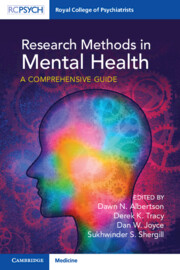Book contents
- Research Methods in Mental Health
- Reviews
- Research Methods in Mental Health
- Copyright page
- Contents
- Contributors
- Foreword
- Foreword
- Section 1 Principles of Research
- Section 2 Tools and Methodologies
- Section 3 Contemporary Applications
- Chapter 12 Children’s and Neurodevelopmental Aspects of Mental Health
- Chapter 13 Women’s Mental Health
- Chapter 14 Mental Health in Developing Countries
- Chapter 15 Social Psychiatry
- Chapter 16 Current Trends
- Index
- References
Chapter 14 - Mental Health in Developing Countries
from Section 3 - Contemporary Applications
Published online by Cambridge University Press: 31 October 2025
- Research Methods in Mental Health
- Reviews
- Research Methods in Mental Health
- Copyright page
- Contents
- Contributors
- Foreword
- Foreword
- Section 1 Principles of Research
- Section 2 Tools and Methodologies
- Section 3 Contemporary Applications
- Chapter 12 Children’s and Neurodevelopmental Aspects of Mental Health
- Chapter 13 Women’s Mental Health
- Chapter 14 Mental Health in Developing Countries
- Chapter 15 Social Psychiatry
- Chapter 16 Current Trends
- Index
- References
Summary
Developing countries (a term often used interchangeably with low- and middle-income countries) account for the overwhelming majority of the world’s population. There is a huge burden of mental illness coupled with deficits in mental healthcare resources and infrastructure that perpetuates a high treatment gap in most developing countries. Good quality scientific research can help in understanding the challenges and evaluating solutions to improve mental healthcare delivery. However, there is a substantial scarcity of research from developing countries. This chapter discusses the unique nature of strengths and challenges with respect to mental health and provides examples of successful scientific mental health research with public health implications from developing countries. The feasible solutions to improve mental healthcare research across individual, organisational, and national level in developing countries given the unique strengths and deficits are discussed in detail.
Information
- Type
- Chapter
- Information
- Research Methods in Mental HealthA Comprehensive Guide, pp. 233 - 248Publisher: Cambridge University PressPrint publication year: 2025
References
Accessibility standard: WCAG 2.0 A
Why this information is here
This section outlines the accessibility features of this content - including support for screen readers, full keyboard navigation and high-contrast display options. This may not be relevant for you.Accessibility Information
Content Navigation
Allows you to navigate directly to chapters, sections, or non‐text items through a linked table of contents, reducing the need for extensive scrolling.
Provides an interactive index, letting you go straight to where a term or subject appears in the text without manual searching.
Reading Order & Textual Equivalents
You will encounter all content (including footnotes, captions, etc.) in a clear, sequential flow, making it easier to follow with assistive tools like screen readers.
You get concise descriptions (for images, charts, or media clips), ensuring you do not miss crucial information when visual or audio elements are not accessible.
Visual Accessibility
You will still understand key ideas or prompts without relying solely on colour, which is especially helpful if you have colour vision deficiencies.
Structural and Technical Features
You gain clarity from ARIA (Accessible Rich Internet Applications) roles and attributes, as they help assistive technologies interpret how each part of the content functions.
